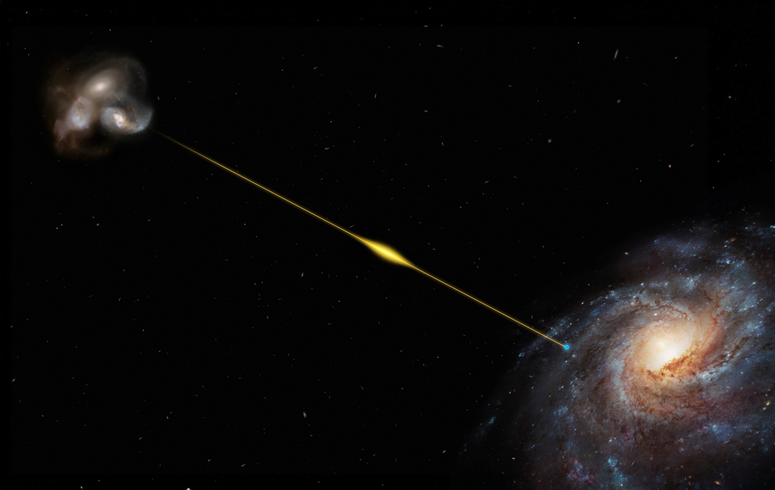Astronomers observe a strange phenomenon from a galaxy far, far away

Scientists believe that the phenomenon is merely wireless communications transmitted through space and originating from aliens (AFP)
A flash of electromagnetic waves lasting less than a millisecond
Astronomers have discovered an extremely powerful stream of radio waves coming from a very distant galaxy , which took 8 billion years to reach Earth , a discovery that will help unravel the mystery of this cosmic phenomenon.
According to a study published yesterday, Thursday, this “fast radio burst,” which is a flash of electromagnetic waves that lasts less than a thousandth of a second, finally reached Earth on June 10, 2022, and an Australian telescope was able to capture its signal.
It turned out that this flow came from a galaxy much farther away than the one that was the source of previously recorded fast radio bursts, as it crossed 8 billion light-years, a time when the universe was less than half its current age, according to what astronomers revealed in the magazine "Science". ".
Since the discovery of such signals for the first time in 2007, scientists have wondered about the exact origin of this cosmic phenomenon, which is difficult to determine because it is hidden.
Because these signals are repeated sometimes, some initially assumed that they were wireless communications transmitted through space and originating from aliens.

In a more serious hypothesis, scientists believe that the origin of these flows is a very dense dead star called a magnetar, which has an extremely strong field.
Co-author of the study, Ryan Shannon from Australia's Swinburne University (in Melbourne), said in a statement to Agence France-Presse that the ability of the ESCAP telescope located in Western Australia to monitor these fast radio bursts is "amazing."
The astrophysicist added, "We were lucky because we were able to observe this small point in the sky for a fraction of a thousandth of a second, after the flow had passed 8 billion years to be observed."
This new radio flux far exceeded the previous record for a similar flux that took 5 billion light-years to reach Earth. The new flow was so powerful that, in less than a thousandth of a second, it released as much energy as the sun emits in 30 years.
The scientist explained, "The sky witnesses perhaps hundreds of thousands of fast radio bursts every day, but only a thousand of them have been observed so far, and researchers were only able to determine the galaxy from which they came from, knowing that it is an essential element for understanding this phenomenon."
To determine the source of this distant radio burst, called FRB 20220610A, researchers turned to the VLT telescope in Chile.

This telescope showed that the signal is coming from a very dense galaxy that may have merged with one or two other galaxies, resulting in the appearance of the strange magnetar, but Ryan Shannon said that this explanation is nothing more than scientists' "best hunch."
He explained that the committee responsible for giving the final opinion had not yet decided on its reasons, given that the radio bursts were detected in unexpected places, including within the Milky Way galaxy.
In the meantime, these radio flows may contribute to clarifying another mystery, which is the amount of solid matter in the universe, which is believed to represent about 5 percent of the universe, while the rest consists of dark matter and dark energy.
However, the problem is that more than half of this five percent of the solid matter is missing, and scientists believe it lies in the cosmic web, which are thin threads of gas that connect galaxies to each other, but which are so widespread that they are not visible to telescopes.
This gas actually causes changes in the wavelength of fast radio bursts, thus making it possible to measure the intensity of the latter.

The fast radio bursts recorded by the Australian telescope bear the signature of “excess matter,” according to the researcher. A large number of radio waves still need to be recorded to improve calculations of missing matter.
In fact, new telescopes dedicated to radio astronomy are expected soon.
Source : websites

